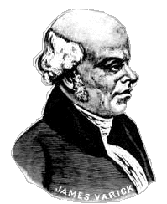History of The African Methodist Episcopal Zion Church
1796 thru 1822
The following is excerpted from The History of the Negro Church, by Dr. Carter G. Woodson:
 Another secession of the Methodists from the white connection was in progress in other parts.
Another secession of the Methodists from the white connection was in progress in other parts.
A number of Negroes, most of whom were members of the John Street Methodist Episcopal Church, in New York City, took the first step toward separation from that connection in 1796.
They had not been disturbed in their worship to the extent experienced by Richard Allen and his coworkers in Philadelphia, but they had a desire for the privilege of holding meetings of their own, where they might have an opportunity to exercise their spiritual gifts among themselves, and thereby be more useful to one another.
Such permission was obtained from Bishop Francis Asbury by a group of intelligent Negro Methodists, chief among whom were Francis Jacobs, William Brown, Peter Williams, Abraham Thompson, June Scott, Samuel Pontier, Thomas Miller, William Miller, James Varick and William Hamilton.
Three of these persons, Abraham Thompson, June Scott, and Thomas Miller, were at that time recognized preachers, and William Miller was an exhorter, all of them officiating in this capacity as opportunities presented themselves in their connection and under the supervision of the white Methodists.
These workers continued in this situation until the year 1799, when, with a further increase in the Negro membership of the Methodist Episcopal Church in New York City, they proposed to build a separate house of worship rather than merely hold separate meetings in the edifice belonging to the white Methodists.
A meeting was held soon thereafter and arrangements were made for the purchase of a lot in Orange Street, between Cross and Chatham, on which after having paid the amount of $50, they found out that the title was involved and they thereafter purchased a site situated at the corner of Church and Leonard Streets and fronting on Church Street. Upon this site they erected a building in the year 1800, naming the edifice the African Methodist Episcopal Zion Church.
Their white friends, seeing that they were determined to be a separate body, appointed as their adviser Rev. John McClaskey, who instructed them how to proceed in drawing up the articles of government. A charter was secured in 1801 and bears the signatures of Peter Williams and Francis Jacobs.
This church had not proceeded very far before there arose some dissension in the ranks. The first exhibition of this was the effort of two of the founders, Abraham Thompson and June Scott, who, induced by the expectation of filthy lucre, tried to form a society separate from the Zion church.
In this they were aided by a white man who desired to exercise his own spiritual gifts, the opportunity for which he could not secure among his own people who belonged to the Society of Friends, from which he had been expelled. This new organization was finally effected as the Union Society.
Very soon thereafter Abraham Thompson repented of his action and abandoned the attempt, leaving June Scott to continue the work of the Union Society by himself. As he was unable to bear the expenses thereafter the society was consequently broken up and June Scott attached himself to another church.
Another obstacle appeared in 1813 when Thomas Simpkins, upon being expelled from the Zion Church, of which he had been a member and a trustee, undertook to establish a new society. He drew to himself William Miller, who had been ordained deacon in the Zion Church.
Obtaining thereafter a site in Elizabeth Street, they succeeded in persuading a number of members of the Zion Church to unite with them to establish the Asbury Church. Unlike the unsuccessful attempt of Abraham Thompson and June Scott in forming the Union Society, the Asbury Church became permanently established.
Desiring, however, to be regular in their operations, the members of the Asbury Church found themselves compelled to appeal to the same ecclesiastical authorities and to accept practically the same government as that already instituted for the Zion Church. This church was thereafter received in the Methodist Church.
Although this was considered a very bad omen for the Zion Church, however, it continued to make progress in spite of expectations to the contrary. The members of the church decidedly increased and steps were taken for the construction of a house with a school room underneath on the site of the old meeting house.
On the 25th of November there began the construction of a more suitable building which was completed by 1820.
Another disturbing factor appeared in the scheme of William Lambert. He had been a member of the Zion Church and seceded with those who formed the Asbury connection.
Because the Zion Church refused to appoint him as a minister, and even Asbury refused to hear him preach, he returned from Philadelphia where he had been under the influence of Bishop Richard Allen, from whom he had obtained a license to preach, and endeavored to establish a church for Bishop Allen’s denomination. He obtained a school house in Mott Street, and with the assistance of Rev. Mr. White, a member and an ordained deacon, it was fitted for a church.
In the meantime Bishop Allen was in touch with some of the official brethren in New York City with a view to extending the jurisdiction of his own church. The supporters of Bishop Allen, moreover, appeared at the opportune moment when the Zionites were without a building and were also without the direction that it had formerly had from the white Methodists, inasmuch as the latter were disturbed by a schism resulting from differences as to church government.
Further disturbance was, therefore, caused when Henry Harden entered the city of New York in 1820 and commenced to form a society of African Methodists with the assistance of William Lambert and Rev. Mr. White.
The Zionists bearing it rather grievously that Bishop Allen had thus tried to invade that field, decided that they would neither preach for the Allenites nor permit the Allenites to preach for them. In this resolution, William Miller, the minister of the Asbury Church, acquiesced and seemingly agreed thereby to connect himself closely with the Zionites.
The church of Richard Allen’s connection, however, did not displease all the persons concerned.
According to the account of Christopher Rush, who himself became a bishop of the African Methodist Episcopal Zion Church, although Richard Allen arrived and sanctioned all that had been done by those men who were working for the progress of his denomination, his presence seemed soon to alter the minds of the Zion preachers, for notwithstanding their resolution to discountenance the proceedings of the Bishop, yet some of them went to their meetings, some of them sat in their altar, and one of them, James Varick, opened meeting for the Bishop on the second or third Sunday night of the existence of that society.
During the first years of their separation the African Methodists in New York had the cooperation of the whites and the funds necessary for the construction of their building and the maintenance of their ministers came from that source. In the course of time, however, the funds contributed by the people of color themselves increased with this growing desire for independence.
The schism in the white church, moreover, stimulated this desire for thorough separation from the white Methodists inasmuch as their so-called superiors were divided in their views as to questions of polity.
Methodists of color believed that they should avail themselves of the opportunity to control their own affairs.
They had at first had for pastors white Methodist preachers with the local preachers of color serving under them. They thereupon notified the white Methodists that they no longer felt themselves obligated to look to them for supplying the pulpit and that they did not desire to have their property involved in the difficulties contemplated by the proposed act of incorporation which had led to the schism.
The Zionites were in a state of indecision, however, for the reason that not having left the white Methodist Church in a snarl as did the followers of Richard Allen, the Zionites had no particular grievance to serve as a cohesive force. Many had thought either of returning to the white Methodists or joining the Allenites. There soon came a time then when it was necessary for the Zionites to decide exactly what they would do.
This being the case, an official meeting was held on August 11, 1820, for the purpose of considering the serious state of the church. Two important questions were propounded at this meeting, one being: Shall we return to the white people? The answer was negative. The next question was: Shall we join Bishop Allen? The answer was also negative. They, therefore, decided to take steps for establishing a firm church government of their own.
Several efforts have since been made to unite the African Methodists but to no avail. Being desirous, however, to proceed regularly rather than radically, these African Methodists sought ordination and consecration through some branch of the Christian Church.
They sent a committee to make such a request of Bishop Hobart of the Episcopal Church, but he was unable to serve them.
They then appealed to the bishop of the Methodist Church, but they were put off in one way or another, with excuses of the bishop having no power to act without the conference and with the request that they should defer action until the conference should have time to investigate.
They thereafter appealed to the conference in session in Philadelphia and were encouraged by a favorable resolution to expect that such service would be rendered them. For some reason they appealed to the conference in New York, which finally refused to grant their request.
The Zionites were then reduced to radical measures in that they had finally to follow in the footsteps of the Asbury Church in ordaining its own deacons and elder.
Becoming thus aggressive, the Zionites, like the Allenites, had taken the offensive. They extended their operations through missionaries into Flushing, New Haven, Long Island, and even into Philadelphia, where certain persons separating from the connection of Richard Allen, organized the Wesleyan Church and joined the Zionites.
Under the leadership of such men as James Varick, George Collins, Charles Anderson, and Christopher Rush, they drew up the doctrines and discipline of the African Methodist Episcopal Church in America, elected a number of elders, and finally organized in 1821 a national body, of which James Varick became the first bishop in 1822.


